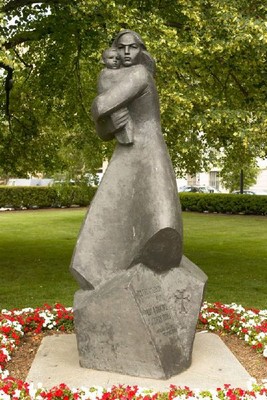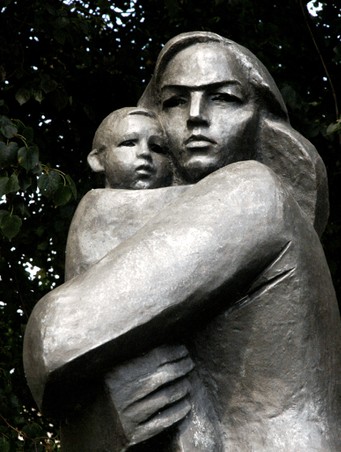Motherland (Armenian Earthquake Statue)
Introduction
Text-to-speech Audio
Images
The sculpture on the lawn in front of the American Red Cross National Headquarters in Washington, D.C.

The sculpture was inspired by the story of Susanna Petrosyan, a mother who was trapped with her four-year-old daughter beneath the rubble for several days.

Backstory and Context
Text-to-speech Audio
At 11:41 a.m. local time on December 7, 1988, a 6.9 magnitude earthquake struck approximately three miles from Spitak, a city of nearly 30,000 people in the northwestern region of the Soviet republic of Armenia. Occurring relatively close to the Earth’s surface, the tremor was felt as far away as Turkey and Iran. A mere four minutes later, a second earthquake, with a magnitude of 5.8, shook the ground again. The earthquakes combine to almost completely level the city of Spitak and destroyed roughly eighty percent of the buildings in the city of Leninakin (now Gyumri), Armenia’s second-largest city, thirty miles to the west. The level of destruction overwhelmed Armenia’s resources. Exacerbating the situation, the country’s Soviet-controlled authorities were slow to allow rescuers and relief workers to enter the area. In all, the earthquakes killed between 25,000 and 60,000 people, and injured over 100,000 more. Destroying hundreds of thousands of structures in the northern part of the country, the tremors left more than 500,000 Armenians homeless.
On the day of the earthquakes, the general secretary of the Communist Party of the Soviet Union, Mikhail Gorbachev, was on an official visit to the United States, where he delivered a speech to the United Nations General Assembly in New York City. The speech was historic for it not only was the first given by a Soviet leader to the global organization in nearly three decades, but also announced the Soviet Union’s plans for unilateral arms and troop reductions, in addition to the shrinking of its military presence in Eastern Europe. After delivering the speech, he met with President Ronald Reagan and President-elect George H.W. Bush. Following his visit to the United States, Gorbachev toured the devastation in Armenia. He also made the surprising and unprecedented move of requesting international humanitarian aid to help the people of the small Soviet republic. One of the organizations that responded to Gorbachev’s call was the American Red Cross. In the year following the earthquakes, the organization donated over $14 million in disaster assistance. Of the total amount, the American Red Cross gave $8 million worth of medicine and medical supplies and $6.5 million in cash. The organization also set up a prosthetics workshop, a spinal trauma rehabilitation unit, and an emergency preparedness program.
Following the disaster and the influx of foreign aid, Armenian sculptor Friedrich Sogoyan went to work creating a statue. The result of his labors was Motherland, a stylized bronze sculpture of a mother closely clutching her child. Completed in 1990, the piece was inspired by the story of Susanna Petrosyan, a mother and her four-year-old daughter who were trapped beneath the rubble of her sister-in-law Karine's apartment. The pair had gone to visit the sister-in-law in her fifth-floor apartment moments before the earthquake. After two days, Karine was dead and their only food- a jar of preserves, was gone. ″I thought my child was going to die of thirst,″ Petrosyan explained to a reporter after their rescue. ″I had no water, no fruit juice, no liquids. It was then I remembered that I had my own blood.″
Concerned only with the survival of her child, Petrosyan lacerated her hand to provide liquid for the girl to drink after both had gone days without water. Miraculously, rescue workers uncovered the rubble and discovered the mother and daughter after eight days. Petrosyan's husband was with the rescue crew that discovered his wife and daughter, and after both were airlifted to a nearby hospital, the mother and daughter survived. Doctors were unsure if the small amount of blood helped preserve the daughter's life, but it was clear that offering something to drink helped to alieve the child's thirst. "″I knew I was going to die,″ Susanna Petrosyan explained to a reporter when recounting her decision ″but I wanted my daughter to live.″
Petrosyan's story was among many miraculous stories of tragedy self-sacrifice. Two weeks after the earthquake, the brutal terrorist attack that killed all 259 passengers on Pan Am Flight 103 over Lockerbie, Scotland took media attention away from the tragedy in Armenia. While the earthquake has been largely forgotten in the United States, the tragedy and the international response continues to play a significant role in the historical memory of Armenians. The following year, Sogoyan presented the sculpture to the American Red Cross as a gift from the people of Armenia in recognition of the organization’s help in the aftermath of the devastating 1988 earthquakes. The sculpture sits on the lawn outside the American Red Cross National Headquarters on Seventeenth Street NW in Washington, D.C.
Sources
Augliere, Bethany. "Benchmarks: December 7, 1988: A Massive Earthquake Devastates Armenia." Earth: The Science Behind the Headlines. American Geosciences Institute. 7 December 2018. Web. 6 February 2021 <https://www.earthmagazine.org/article/benchmarks-december-7-1988-massive-earthquake-devastates-armenia>.
History.com Editors. "Earthquakes wreak havoc in Armenia." History. A&E Television Networks. 3 December 2019. Web. 6 February 2021 <https://www.history.com/this-day-in-history/john-paul-jones-sets-sail>.
Hopkins, Whitney. "From the Archives - Motherland." Red Cross Chat. American Red Cross. 3 October 2013. Web. 6 February 2021 <https://redcrosschat.org/2013/10/03/from-the-archives-motherland/>.
Mitchell, Charles. "Soviet leader Mikhail Gorbachev." UPI, December 7, 1988 <https://www.upi.com/Archives/1988/12/07/Soviet-leader-Mikhail-Gorbachev-in-his-first-speech-to/1407597474000/>.
John-Thor, Dalhburg. Trapped Woman Gave Daughter Her Blood to Keep Her Alive, AP News. December 28th 1998. Accessed February 7th 2021. https://apnews.com/article/edb7271a218c0874df4479740ec5d340.
https://redcrosschat.org/2013/10/03/from-the-archives-motherland/
https://www.foresthillsconnection.com/style/washington-dc-a-photographers-paradise/
